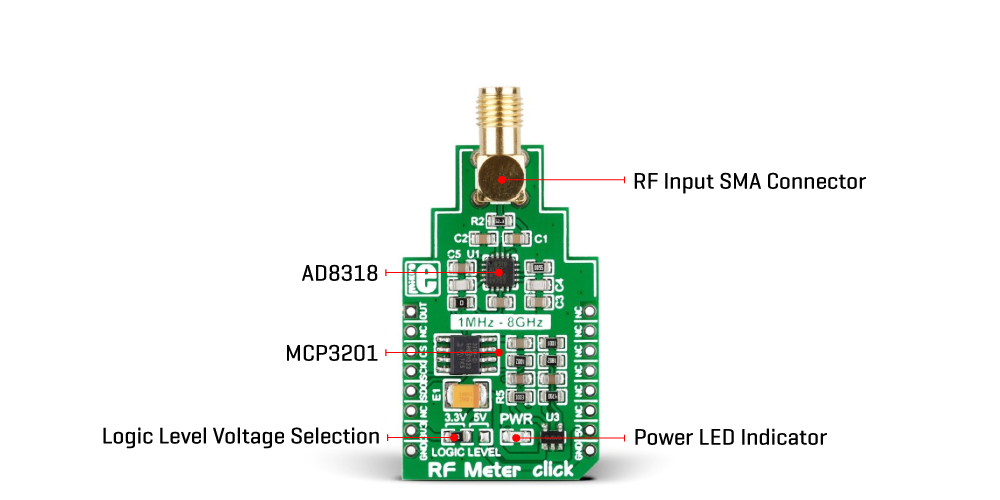50%
OFF
GO LOCAL
| Company | Stock | Price |
|---|---|---|


4G LTE 2 Click - Voice

Clock Gen Click

Fusion for ARM v8 with STM32F407ZG over USB-C

Shuttle Click

Stepper 21 Click

mikroBUS Shuttle
MIKROE-2034
28 g
Status:
RF Meter Click is a compact add-on board that measures radio frequency power. This board features the AD8318, a logarithmic detector/controller from Analog Devices. It covers a frequency span from 1MHz up to 8GHz over a 60dB range, approximately. The AD8318 acquires the signal over an external antenna, which is then processed by the logarithmic detector of the AD8318. The resulting voltage of the AD8318 is then fed into an MCP3201, a 12-bit ADC with SPI serial interface for further processing. This Click board™ makes the perfect solution for testing equipment, including RF transmitters or relays. It enables monitoring and measuring frequency levels to ensure proper functioning and leak detection.
RF Meter Click is supported by a mikroSDK compliant library, which includes functions that simplify software development. This Click board™ comes as a fully tested product, ready to be used on a system equipped with the mikroBUS™ socket.
This product is no longer in stock
Availability date:
50%
OFF
| Company | Stock | Price |
|---|---|---|

RF Meter Click is based on the AD8318, a logarithmic detector/controller from Analog Devices. It is a demodulating logarithmic amplifier capable of accurately converting an RF input signal to a corresponding decibel-scaled output voltage. It employs the progressive compression technique over a cascaded amplifier chain, with each stage equipped with a detector cell. The AD8318 can be used in measurement or controller mode of operation. It maintains accurate log conformance for signals of 1MHz to 6GHz and provides operation up to 8GHz. The input range is typically 60dB with an error of less than ±1dB and a 10ns response time that enables RF burst detection beyond 45MHz. In addition, the AD8318 comes with an integrated temperature sensor with independent output which can be used as a temperature compensation.

The voltage output of the AD8318 goes to the MCP3201, a successive approximation 12-bit analog-to-digital converter with an onboard sample and hold circuitry from Microchip. This ADC provides a single pseudo-differential output, with sample rates of up to 100ksps. To provide correct values, this Click board™ uses an AP7331 LDO linear regulator to provide referent voltage to the MCP3201. The RF Meter uses a 3-wire SPI serial interface of the MCP3201 to communicate to the host MCU over the mikroBUS™ socket. The RF Meter can use either an SPI mode 0 or an SPI mode 1, depending on the needs. The readings of the independent temperature sensor of the AD8318 can be read over the OUT pin mikroBUS™ socket, giving analog values.
This Click board™ can operate with either 3.3V or 5V logic voltage levels selected via the LOGIC LEVEL jumper. This way, both 3.3V and 5V capable MCUs can use the communication lines properly. However, the Click board™ comes equipped with a library containing easy-to-use functions and an example code that can be used, as a reference, for further development.
Type
RF meter
Applications
Can be used for testing equipment that includes RF transmitters or relays. It enables monitoring and measuring frequency levels to ensure proper functioning and leak detection
On-board modules
AD8318 - logarithmic detector/controller from Analog Devices
MCP3201 - 12-bit ADC with SPI serial interface from Microchip
Key Features
Wide bandwidth from 1 MHz to 8 GHz over a 60 dB range, high accuracy, independent temperature measurements, stability over temperature, low power consumption, and more
Interface
GPIO,SPI
Feature
No ClickID
Compatibility
mikroBUS™
Click board size
M (42.9 x 25.4 mm)
Input Voltage
3.3V or 5V
This table shows how the pinout on RF Meter Click corresponds to the pinout on the mikroBUS™ socket (the latter shown in the two middle columns).
| Label | Name | Default | Description |
|---|---|---|---|
| - | PWR | - | Power LED Indicator |
| - | LOGIC LEVEL | Left | Logic Level Voltage Selection 3V3/5V: Left position 3V3, Right position 5V |
| Description | Min | Typ | Max | Unit |
|---|---|---|---|---|
| Supply Voltage | 3.3 | - | 5 | V |
| Frequency Range | 0.001 | - | 8 | GHz |
We provide a library for the RF Meter Click as well as a demo application (example), developed using Mikroe compilers. The demo can run on all the main Mikroe development boards.
Package can be downloaded/installed directly from NECTO Studio Package Manager (recommended), downloaded from our LibStock™ or found on Mikroe github account.
Library Description
This library contains API for RF Meter Click driver.
Key functions
Example Description
Demo app measures and displays signal strenght by using RF Meter click board.
void application_task ( void )
{
signal = rfmeter_get_signal_strenght( &rfmeter, RFMETER_DEF_SLOPE, RFMETER_DEF_INTERCEPT );
log_printf( &logger, "Signal strenght: %.2f dBm rn", signal );
Delay_ms( 1000 );
log_printf( &logger, "-----------------------rn" );
}
The full application code, and ready to use projects can be installed directly from NECTO Studio Package Manager (recommended), downloaded from our LibStock™ or found on Mikroe github account.
Other Mikroe Libraries used in the example:
Additional notes and informations
Depending on the development board you are using, you may need USB UART click, USB UART 2 Click or RS232 Click to connect to your PC, for development systems with no UART to USB interface available on the board. UART terminal is available in all Mikroe compilers.
This Click board™ is supported with mikroSDK - Mikroe Software Development Kit. To ensure proper operation of mikroSDK compliant Click board™ demo applications, mikroSDK should be downloaded from the LibStock and installed for the compiler you are using.
For more information about mikroSDK, visit the official page.
NOTE: Please be advised that any peripheral devices or accessories shown connected to the Click board™ are not included in the package. Check their availability in our shop or in the YMAN section below.